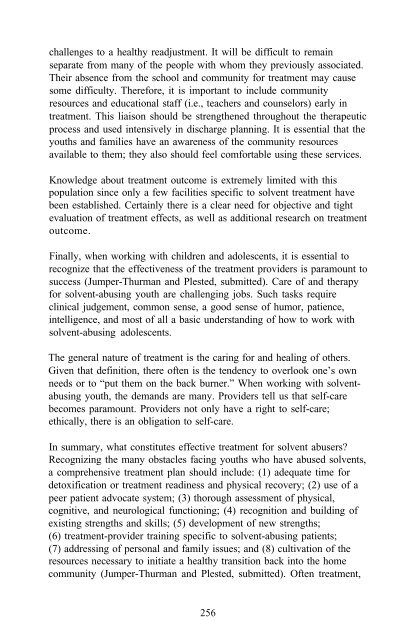Epidemiology of Inhalant Abuse - Archives - National Institute on ...
Epidemiology of Inhalant Abuse - Archives - National Institute on ...
Epidemiology of Inhalant Abuse - Archives - National Institute on ...
You also want an ePaper? Increase the reach of your titles
YUMPU automatically turns print PDFs into web optimized ePapers that Google loves.
challenges to a healthy readjustment. It will be difficult to remain<br />
separate from many <str<strong>on</strong>g>of</str<strong>on</strong>g> the people with whom they previously associated.<br />
Their absence from the school and community for treatment may cause<br />
some difficulty. Therefore, it is important to include community<br />
resources and educati<strong>on</strong>al staff (i.e., teachers and counselors) early in<br />
treatment. This liais<strong>on</strong> should be strengthened throughout the therapeutic<br />
process and used intensively in discharge planning. It is essential that the<br />
youths and families have an awareness <str<strong>on</strong>g>of</str<strong>on</strong>g> the community resources<br />
available to them; they also should feel comfortable using these services.<br />
Knowledge about treatment outcome is extremely limited with this<br />
populati<strong>on</strong> since <strong>on</strong>ly a few facilities specific to solvent treatment have<br />
been established. Certainly there is a clear need for objective and tight<br />
evaluati<strong>on</strong> <str<strong>on</strong>g>of</str<strong>on</strong>g> treatment effects, as well as additi<strong>on</strong>al research <strong>on</strong> treatment<br />
outcome.<br />
Finally, when working with children and adolescents, it is essential to<br />
recognize that the effectiveness <str<strong>on</strong>g>of</str<strong>on</strong>g> the treatment providers is paramount to<br />
success (Jumper-Thurman and Plested, submitted). Care <str<strong>on</strong>g>of</str<strong>on</strong>g> and therapy<br />
for solvent-abusing youth are challenging jobs. Such tasks require<br />
clinical judgement, comm<strong>on</strong> sense, a good sense <str<strong>on</strong>g>of</str<strong>on</strong>g> humor, patience,<br />
intelligence, and most <str<strong>on</strong>g>of</str<strong>on</strong>g> all a basic understanding <str<strong>on</strong>g>of</str<strong>on</strong>g> how to work with<br />
solvent-abusing adolescents.<br />
The general nature <str<strong>on</strong>g>of</str<strong>on</strong>g> treatment is the caring for and healing <str<strong>on</strong>g>of</str<strong>on</strong>g> others.<br />
Given that definiti<strong>on</strong>, there <str<strong>on</strong>g>of</str<strong>on</strong>g>ten is the tendency to overlook <strong>on</strong>e’s own<br />
needs or to “put them <strong>on</strong> the back burner.” When working with solventabusing<br />
youth, the demands are many. Providers tell us that self-care<br />
becomes paramount. Providers not <strong>on</strong>ly have a right to self-care;<br />
ethically, there is an obligati<strong>on</strong> to self-care.<br />
In summary, what c<strong>on</strong>stitutes effective treatment for solvent abusers?<br />
Recognizing the many obstacles facing youths who have abused solvents,<br />
a comprehensive treatment plan should include: (1) adequate time for<br />
detoxificati<strong>on</strong> or treatment readiness and physical recovery; (2) use <str<strong>on</strong>g>of</str<strong>on</strong>g> a<br />
peer patient advocate system; (3) thorough assessment <str<strong>on</strong>g>of</str<strong>on</strong>g> physical,<br />
cognitive, and neurological functi<strong>on</strong>ing; (4) recogniti<strong>on</strong> and building <str<strong>on</strong>g>of</str<strong>on</strong>g><br />
existing strengths and skills; (5) development <str<strong>on</strong>g>of</str<strong>on</strong>g> new strengths;<br />
(6) treatment-provider training specific to solvent-abusing patients;<br />
(7) addressing <str<strong>on</strong>g>of</str<strong>on</strong>g> pers<strong>on</strong>al and family issues; and (8) cultivati<strong>on</strong> <str<strong>on</strong>g>of</str<strong>on</strong>g> the<br />
resources necessary to initiate a healthy transiti<strong>on</strong> back into the home<br />
community (Jumper-Thurman and Plested, submitted). Often treatment,<br />
256
















